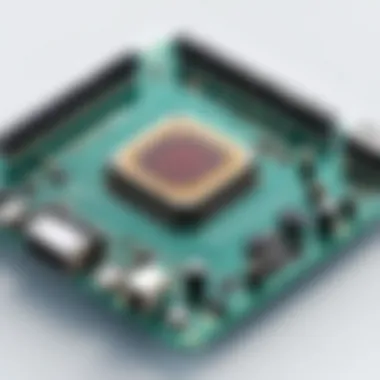An In-Depth Exploration of Embedded System Devices


Intro
Embedded systems lie at the very crux of modern technology, intricately linking the realms of hardware and software. These systems, often hidden from plain sight, drive a multitude of devices we encounter daily. Their importance transcends mere functionality; embedded systems enhance efficiency, performance, and capability across various domains, including consumer electronics, automotive, healthcare, and industrial automation.
By examining the architecture and functionality of embedded systems, one gains insight into their design considerations and operational nuances. Such an exploration not only informs about existing technologies but also opens a window to future innovations. Throughout this article, we aim to provide a comprehensive guide that dissects the components and emerging trends of embedded systems.
As we dive deeper into the subject, we will traverse essential concepts and practices that govern this fascinating field. The goal is to ensure that whether you are a novice eager to understand the basics or a seasoned professional seeking advanced knowledge, you will find valuable insights here.
Defining Embedded Systems
Embedded systems are crucial in the modern world, blending hardware and software to perform specific tasks. Understanding these systems is essential for various fields, from IT professionals to cybersecurity experts, as they form the backbone of many everyday devices. Without a grasp of what embedded systems are, one might overlook their significance and the intricate roles they play in technology.
Understanding the Concept
An embedded system, at its core, is a computing system that performs dedicated functions within a larger mechanical or electrical system. Think of it as a specialized mini-computer designed for one purpose, unlike a general-purpose computer that can run various applications. These systems are typically found in various gadgets like washing machines, microwave ovens, smart thermostats, and even medical devices.
The term "embedded" implies that these systems are integrated into the device they control. They rely on sensors to gather data and actuators to produce an effect based on that data. For instance, a digital thermostat monitors the temperature (sensor) and adjusts the heating or cooling system accordingly (actuator).
Key Characteristics
Embedded systems come with distinct features that set them apart:
- Real-Time Operation: Many embedded systems need to operate within strict time constraints, ensuring that tasks are executed promptly.
- Resource Constraints: Unlike PCs, these systems often have limited processing power, memory, and storage.
- Reliability and Stability: Given their critical functions, embedded systems must be reliable and stable to maintain the proper functioning of devices.
- Power Efficiency: Many embedded devices are designed to work on minimal power, extending battery life and reducing energy consumption.
"Embedded systems are less about user interfaces and more about seamless operation in the background."
In essence, defining embedded systems requires a holistic view of both their operational context and the hardware-software interplay that sustains them. Identifying these characteristics will be fundamental as we delve deeper into the components, architecture, and practical applications in the following sections.
Components of Embedded System Devices
Embedded systems are the backbone of many electronic devices today. Understanding the various components that make these systems function is crucial for any IT professional or student diving into this field. Each element contributes to the overall efficiency and performance of the system, highlighting the harmony needed to achieve a successful embedded device.
- Microcontrollers
Microcontrollers are often referred to as the brains of embedded systems. They are compact integrated circuits that can process data, perform calculations, and provide control over other components like sensors and actuators. Think of microcontrollers as the conductor of an orchestra—each section of the orchestra has its role, but without the conductor, they would struggle to play harmoniously.
A microcontroller consists of a CPU, memory, and input/output peripherals, allowing it to execute specific tasks, from simple operations to complex processes. Their programmability enables developers to customize functionality according to the application needs, making them indispensable in various industries. In consumer electronics, for instance, microcontrollers can be found in remote controls and appliances, ensuring effective user interaction and automatic adjustments based on input.
- Sensors and Actuators
Sensors play a pivotal role in providing real-time data in embedded systems. They collect information from their environment—like temperature, motion, or light—and convert that data into signals that the controller can interpret. For example, a temperature sensor in a thermostat detects the ambient temperature and sends the reading to the microcontroller, which then decides whether to activate the heating element.
Actuators, on the other hand, respond to commands from the microcontroller based on information received from sensors. They convert electrical energy into physical motion. For instance, in automotive applications, if a car's speed sensor indicates a certain speed, the actuator can adjust the throttle position accordingly. This feedback loop allows systems to adapt and modify their behavior dynamically, enhancing functionality and efficiency.
- Memory Units
Memory is a key consideration in embedded system design, as it directly impacts performance. There are two main types of memory: volatile and non-volatile. Volatile memory, like RAM, is utilized for temporary storage during operation, allowing quick read and write access. Non-volatile memory, such as flash memory, retains data even when power is lost, making it useful for storing firmware or configuration settings.
The structure, capacity, and speed of memory impacts how well an embedded system runs. A system with insufficient memory can face bottlenecks, causing delays and inadequate performance. Designers often need to make careful decisions about what type of memory to use and how much to allocate to different tasks, balancing efficiency with cost and available space.
- Power Management Systems
Power management systems are essential in embedded devices that require efficient energy consumption. They ensure that power is distributed according to necessity whilst extending battery life and reducing heat generation. Power management can involve a variety of strategies, such as sleep modes where components are powered down when not in use or dynamic voltage scaling that adjusts power usage based on workload demands.
These systems must be designed to meet the unique power requirements of each embedded application. For example, IoT devices often operate in remote locations where battery life is critical. Without effective power management, the devices could fail, leading to data loss or malfunction.
"In the world of embedded systems, optimizing components for power efficiency while maintaining performance is akin to finding gold on a tightrope."
Understanding these components is more than just a technical exercise; it is about grasping the careful balance between performance, cost, and application needs. Each piece of hardware plays its part, creating intricate interactions that drive functionality in the embedded systems we increasingly rely on today.
Embedded System Architecture
Embedded system architecture plays a crucial role in defining how these systems are structured and operate. A well-designed architecture ensures that the device meets its functional requirements while being efficient and reliable. With embedded systems being integral to countless applications—from household appliances to complex industrial machinery—understanding their architecture becomes essential.


Basic Architecture Models
When talking about basic architecture models, it pertains to the foundational frameworks that guide the design of embedded systems. Typically, these models can be broken down into two primary types: the single-user and multi-user models.
In a single-user architecture, the system is designed to serve one user or application at a time, hence making it simpler and more straightforward to manage. This model is often used in devices like remote controls or basic home appliances, where functionality and ease of use take precedence. On the other hand, multi-user architectures are designed to accommodate multiple applications simultaneously, which is critical for devices such as smartphones and complex machinery in manufacturing settings. Through these models, designers can optimize resource allocation and enhance performance.
Complex System Architectures
Complex embedded systems require intricate architectures to manage their functionalities and interactions efficiently. Two notable types of these architectures are the System-on-Chip (SoC) and Field-Programmable Gate Array (FPGA).
System-on-Chip (SoC)
A System-on-Chip integrates all necessary components of a computer or electronic system onto a single chip. This architecture not only reduces the size of the device but also lowers costs and energy consumption considerably. SoCs bundle various functional units—such as processors, memory, and peripherals—making them a popular choice in the realm of embedded systems.
Key characteristic: The remarkable compactness of SoCs allows manufacturers to create multifunctional devices without sacrificing space or efficiency. A typical application for SoC can be found in smartwatches that need to operate numerous tasks seamlessly in a limited physical space.
Unique feature: One standout aspect of SoCs is the integration of various processing blocks, which enables customization for specific applications. However, this can be a double-edged sword; while it facilitates tailored solutions, it might also pose challenges in terms of development time and costs.
Field-Programmable Gate Array (FPGA)
On the flip side, Field-Programmable Gate Arrays offer a different approach by providing flexibility post-manufacturing. Users can program FPGAs to suit their specific requirements after they've been produced, making them incredibly versatile.
Key characteristic: The most appealing feature of FPGAs is their reconfigurability. This characteristic allows developers to make changes as new needs arise, adapting the system without the need for hardware replacement. As such, they are frequently used in research laboratories and industries where rapid prototyping is a common practice.
Unique feature: FPGAs' adaptability can lead to significant advantages in contexts like telecommunications or data processing, where evolving standards or requirements demand quick adjustments. However, they can require more considerable power and expertise to configure effectively, possibly complicating the development lifecycle for certain projects.
Embedded system architecture isn't just a framework; it serves as the backbone that influences performance, scalability, and overall efficiency in embedded devices.
Understanding these architectures aids IT professionals and students in navigating the increasingly complex world of embedded systems. Each architecture's advantages and disadvantages plays a vital role in determining its application and effectiveness in real-world scenarios.
Software in Embedded Systems
Software plays a crucial role in embedded systems, as it acts as the mediator between the hardware and the user, allowing devices to perform their intended tasks efficiently. Understanding software in this context is essential because it not only dictates the functionality of embedded devices but also influences their reliability and performance. Embedded systems software must be highly optimized, given the resource constraints that are often present, including limited processing power, memory, and energy supply.
Unlike general-purpose software, which can run on different types of hardware and often has room for flexibility in terms of performance, embedded software must be designed with precision. It must directly control hardware components, process input from sensors, and drive actuators based on specific conditions—all in real-time without delay.
Embedded Operating Systems
Embedded operating systems (EOS) are specially designed for embedded systems. They're not like your typical operating systems found on personal computers. An EOS must be lightweight and tailored to run within the constraints of the hardware. This means it often strips away unnecessary functions to deliver only what is essential.
The main benefit of using an embedded operating system is that it provides a stable platform for software developers to build upon, simplifying the development process. These systems can manage hardware resources more efficiently and provide real-time handling of tasks.
Common Examples of Embedded Operating Systems:
- FreeRTOS: An open-source real-time operating system designed for microcontrollers.
- VxWorks: A robust OS used in critical systems requiring reliability and performance.
- Embedded Linux: A version of Linux that has been tailored for embedded devices.
Programming Languages Used
The choice of programming language when developing embedded systems is integral, as it influences how effectively the software can communicate with hardware components. Here’s a closer look at some of the fundamental languages used in embedded system development:
C is arguably the most commonly used language in embedded systems. Its closeness to hardware-level operations allows developers to write efficient code for constrained environments. One key characteristic of C is its ability to provide low-level control over memory and system resources. This makes it advantageous for tasks that require precise timing and resource management.
The unique feature of C is that it allows for direct manipulation of hardware resources through pointers, enhancing performance in critical applications. However, while C offers significant advantages, it also presents challenges, such as the potential for memory management issues, which may lead to vulnerabilities if not handled with care.
++
C++ extends the capabilities of C, adding object-oriented features and allowing for more complex program structures. Thanks to its support for classes and objects, developers can create more maintainable and modular code, which can be a real boon for larger projects.
What defines C++ as beneficial in embedded systems is its flexibility; it combines both low-level manipulation and high-level abstractions. However, the trade-off is the increased complexity and overhead that can sometimes be at odds with the need for efficiency in embedded environments.
Assembly Language


Assembly language is the low-level programming language that closely correlates with machine code. It's predominantly used when developers require utmost performance and control. The primary characteristic of Assembly language is its ability to write code that is directly translated into machine language, offering exceptional speed and efficiency.
The unique advantage of Assembly is in critical applications where timing and resource usage are paramount. However, coding in Assembly can be error-prone and time-consuming, making it less favorable for large-scale projects where development speed and flexibility are required.
Summary:
In embedded systems, the choice of software and programming languages shapes not just functionality but also performance and reliability. Understanding these components is vital for tackling the challenges that come with developing embedded applications effectively.
Application Areas
Understanding the application areas of embedded systems is crucial, as these areas not only highlight the practical uses but also showcase the versatility of embedded devices across various industries. Each sector has unique demands and challenges which embedded systems adeptly address, driving innovation and making lives easier. By exploring these applications, we can better appreciate how embedded systems operate at the heart of modern technology.
Consumer Electronics
In today’s fast-paced world, consumer electronics have taken center stage in the realm of embedded systems. Devices like smartphones, smart TVs, and home assistants illustrate this well. These systems often feature microcontrollers that drive user interfaces, manage connectivity, and process input from various sensors. The convenience offered by smart home devices, such as smart thermostats, hinges on their ability to adapt to user preferences and environmental conditions. For instance, a smart thermostat learns your weekly schedule and adjusts the heating or cooling accordingly, reducing energy consumption while enhancing comfort.
A significant consideration here is the user experience. The operation needs to be seamless and intuitive; hence, embedded systems must be designed with the end-user in mind. Developers often conduct extensive testing to ensure that the response time is quick and the features are user-friendly. If an app takes too long to load, or if the device requires a cumbersome process to perform simple functions, consumers might lose interest quickly. The emphasis on real-time response and feedback in these devices reflects the growing importance of embedded systems in consumer electronics.
Industrial Automation
When one considers industrial automation, the picture changes significantly. Here, reliability and efficiency are paramount. Embedded systems enable automation of manufacturing processes through programmable logic controllers (PLCs) and industrial robots. They facilitate tasks ranging from assembly line operations to quality control, ensuring consistently high standards.
The use of sensors and actuators is vital. They gather data from the production environment, analyze it in real time, and execute commands as needed. As you might expect, system integration is a key concern in this domain. Different systems must communicate effectively, and this requires a focus on interoperability. For instance, if sensors from one manufacturer do not easily interface with the controllers from another, it can lead to downtime and inefficiencies. Therefore, the challenge lies in maintaining flexibility while ensuring robust integration.
Automotive Applications
The automotive sector is increasingly relying on embedded systems to enhance functionality and safety. From advanced driver-assistance systems (ADAS) to infotainment services, embedded devices are crucial. For instance, features like adaptive cruise control or lane-keeping assist use embedded systems to gather real-time data from the vehicle’s surroundings, interpreting this data to make immediate adjustments, contributing immensely to driver safety.
Moreover, the evolution of electric vehicles has also driven development in embedded systems. Battery management systems (BMS) embedded in electric vehicles monitor and control battery performance, ensuring longevity and safety while optimizing energy consumption. Given the focus on reducing carbon emissions, it’s clear that embedded systems play a critical role in shaping the future of automotive technology.
Healthcare Devices
Embedded systems in healthcare are revolutionizing patient care, providing precise monitoring and timely interventions. Devices like pacemakers and diabetes management tools highlight how technology supports critical health functions. The integration of real-time monitoring systems allows healthcare professionals to be alerted to changes in patient conditions almost instantaneously, often before a critical event occurs.
However, the stakes are high in this sector. Security must be front of mind when designing these systems. With the potential for breaches that could compromise patient data or device functionality, manufacturers must adhere to strict regulations and implement strong protective measures. Any lapse can be detrimental not just to business but to patient health as well.
In summary, the application areas of embedded systems are as diverse as they are essential. From everyday electronics to life-saving healthcare technologies, embedded systems form the backbone of numerous applications, ensuring smooth operations and ensuring that the technology enriches rather than complicates our lives. The continual advancements in this field signal a promising future where embedded systems are bound to play an even greater role.
Challenges in Embedded System Design
Designing embedded systems comes with its own knapsack of difficulties. These challenges aren't just technical hitches; they shape the very fabric of how we develop technology that interacts with the physical world. Over the years, the importance of addressing these challenges has grown, especially as embedded systems proliferate in various applications, from smart appliances to advanced industrial machines. A thorough understanding of these hurdles is crucial for IT professionals, cybersecurity experts, and students who engage with this ever-evolving landscape.
Resource Constraints
One of the central challenges faced in embedded system design is dealing with limited resources. Embedded systems often function within strict limitations regarding processing power, memory, and energy consumption. This isn't just an abstract notion; it has real implications for the design process. Engineers must carefully allocate these scarce resources to ensure effective operation within the intended environment.
- Memory Limitations: Many embedded systems operate on microcontrollers that have a tiny footprint. This restricts the amount and complexity of the data they can handle. For instance, imagine a smartwatch that monitors health metrics. If the system’s memory is maxed out with excessive data (like tracking every beat of the heart), it may have to forego other valuable functions like notifications or communication.
- Processing Power: The CPU in an embedded device isn't as robust as those found in desktop computers. Consequently, engineers need to optimize their code and algorithms to perform tasks efficiently. In practice, this might require writing in low-level languages and implementing essential functions directly in the code, avoiding any unnecessary overhead.
Resource constraints aren't merely operational hurdles; addressing them can lead to innovative design solutions, pushing the boundaries of what embedded systems can achieve.
Real-Time Constraints
Embedded systems commonly operate in real-time environments where timely processing and response are paramount. These systems must deliver results within defined time limits—a factor that's critical for applications such as automotive safety systems or industrial automation.
For instance, consider an anti-lock braking system in vehicles. If the response time is even a fraction too slow, it could lead to disastrous outcomes. Therefore, designs have to ensure that systems can process sensor data and issue control commands promptly.
- Latency Issues: Any delay, even milliseconds, can trigger failures. Designers employ techniques such as prioritizing tasks and using efficient scheduling algorithms to mitigate these effects.
- Predictability: Systems must behave predictably under varying conditions, which requires rigorous testing and validation processes. This often leads to tighter integration between hardware and software development cycles—an adjustment that, while complex, pays dividends in reliability.
Integration Issues
As the sophistication of embedded systems increases, so too do the challenges associated with integration. Many devices now rely on a multitude of components, including sensors, processors, and communication modules. This interdependence can lead to complications that impact system performance and reliability.
- Interoperability: Different components may adhere to various standards. This can make integrating them a painstaking process. For example, a smart thermostat must seamlessly communicate with diverse HVAC systems and sensors from different manufacturers. Discrepancies in communication protocols can result in malfunctions or inefficient operations.
- Software Compatibility: Embedded systems use a variety of development environments and libraries. Ensuring that the embedded software runs smoothly across different platforms requires careful selection of compatible tools.
"Integrating multiple components is often like fitting together pieces of a puzzle; if one piece doesn’t match, the entire picture can be skewed."


These integration challenges require a systematic approach to design and development—adopting industry best practices while experimenting with innovative solutions. As the embedded systems industry continues to evolve, understanding and navigating these challenges will be key to developing robust and efficient devices.
Security Considerations
The importance of security in embedded systems cannot be overstated. As the world becomes increasingly connected, with devices communicating over various networks, the potential for security breaches has never been higher. Whether it’s a simple smart thermostat in a home or a complex industrial control system, these devices must be designed with security features from the ground up. Vulnerabilities in embedded systems can lead to significant risks, including data theft, operational disruptions, and even physical harm.
Protecting embedded systems involves a multifaceted approach that considers the unique characteristics and constraints of these devices. Security is not just an afterthought; it’s integral to the design and functionality. Understanding the potential threats leads to better protective measures, ultimately fostering trust in these systems.
Threats to Embedded Systems
Embedded systems face a plethora of threats, often more severe than those encountered by traditional computing systems. Some notable threats include:
- Unauthorized Access: Attackers may exploit weak access controls to gain entry into the system. This could lead to unauthorized manipulation of device functions.
- Malware Infections: Just like PCs, embedded devices can be susceptible to malware. This can result in data loss and device failure, especially in crucial sectors like healthcare.
- Physical Tampering: Physical access to embedded systems allows attackers to alter the hardware or software configurations, with potential disastrous outcomes.
- Network Attacks: Many embedded devices connect to the Internet or other networks. Cyber attackers may execute man-in-the-middle attacks, eavesdropping on communications or injecting malicious commands.
"In the world of embedded systems, being secure means being prepared for the unpredictability of the threat landscape."
Protective Measures
To defend against these threats, a range of protective measures must be implemented. These can include:
- Strong Authentication: Implementing robust authentication protocols ensures that only authorized users can access and control the embedded systems. Utilizing multi-factor authentication can significantly enhance security.
- Regular Updates and Patching: Just like any software, embedded systems require regular updates to address vulnerabilities. Manufacturers should provide timely updates to patch known issues.
- Encryption: Encryption of data both at rest and in transit can protect sensitive information from eavesdroppers, significantly reducing the risk of data breaches.
- Secure Boot Mechanisms: Establishing secure boot processes helps ensure that only legitimate and tamper-free firmware is loaded during the device startup.
- Intrusion Detection Systems: Implementing IDS provides real-time monitoring of embedded systems, allowing for immediate responses to potential threats.
By addressing these concerns with diligence, organizations can enhance the resilience of embedded systems against various forms of attacks, paving the way for safer and more reliable devices in a connected world.
Future Trends in Embedded Systems
In the ever-evolving technology landscape, embedded systems are steering a course toward greater functionality, efficiency, and interconnectivity. These trends not only shape the design and application of embedded devices but also redefine how industries and consumers interact with technology. Understanding these trends is crucial for IT professionals, cybersecurity experts, and students who are aiming to stay ahead in a realm that is becoming increasingly intricate and intertwined.
Internet of Things (IoT)
The Internet of Things stands as a linchpin in the future of embedded systems. By connecting a vast range of devices over the internet, the IoT enables real-time data sharing and remote monitoring, enriching user experiences and improving operational efficiencies. Here’s how IoT is making waves:
- Permeation Across Industries: From smart homes equipped with interconnected appliances to industrial applications like predictive maintenance, IoT redefines operational paradigms. Imagine a scenario where refrigerators monitor their contents and automatically reorder groceries when supplies run low.
- Data-Driven Insights: With billions of sensors gathering data, organizations can analyze trends and behaviors at an unprecedented scale. They can make more informed decisions, optimize processes, and even predict future needs.
- Security Vulnerabilities: While the benefits are plentiful, the proliferation of IoT devices also raises concerns. Each connected device represents a potential attack vector, requiring robust security measures to protect sensitive data and maintain user trust.
"With great power comes great responsibility." Utilizing IoT effectively means not only prioritizing functionality but also securing the devices and data they manage.
Machine Learning Integration
Machine learning is rapidly becoming the backbone of advanced embedded systems. The integration allows devices to learn from data patterns and make autonomous decisions, which brings numerous advantages:
- Enhanced Performance: Embedded devices equipped with machine learning can adapt to changing conditions automatically. For example, a thermostat that learns your habits can optimize heating and cooling without manual input.
- Predictive Maintenance: In industrial settings, machine learning can sift through tons of data from machinery to predict failure before it occurs, saving companies time and reducing costs associated with downtime.
- Personalization: Whether it’s a wearable fitness tracker or a smart speaker, machine learning enables devices to tailor experiences to individual users, improving satisfaction and engagement.
The growing reliance on machine learning does come with challenges, chiefly regarding data privacy. The effectiveness of these systems hinges on abundant data, raising concerns over unauthorized access and misuse.
Advancements in Processor Technology
Innovations in processor technology are propelling embedded systems into a new era of capability and efficiency:
- Lower Power Consumption: Recent developments in low-power processors extend the life of battery-operated devices, making them more viable for widespread use, especially in remote applications.
- Increased Processing Power: As processors become more robust, embedded systems can handle more complex computations, facilitating sophisticated applications such as real-time video processing in surveillance systems.
- Cost Efficiency: Advances in semiconductor technology are lowering the manufacturing costs of processors, enabling more devices to utilize advanced features previously restricted to high-end systems.
Ultimately, these advancements signal a shift toward smarter, more efficient embedded devices that can integrate seamlessly into various ecosystems, underscoring the importance of innovation in sustaining competitive advantage in the market.
Finale
In wrapping things up, the exploration of embedded system devices highlights not only their significance but also their intricate design and multifaceted applications. These devices are the unsung heroes of modern technology, seamlessly weaving through our daily lives while driving innovation across various industries.
Importance of Embedded Systems
Embedded systems' importance lies primarily in their ability to perform dedicated functions with high efficiency. These systems optimize performance, often relegating complex operations to the background, which leads to enhanced user experience in diverse applications ranging from consumer electronics to healthcare devices.
"Embedded systems may not always steal the spotlight, but their impact is monumental."
Key Considerations
When considering the future of embedded systems, several vital elements must be taken into account:
- Resource Management: Good design must take into account memory, power, and processing capabilities to ensure performance without waste.
- Scalability: As technology rapidly advances, scalability becomes crucial for embedded systems to adapt to future demands and technologies.
- Security: With their growing connectivity, embedded systems can become a target for cyber threats. Thus, integrating robust security measures from the design phase is paramount.
Benefits to Industries
The benefits of understanding embedded systems extend beyond technical knowledge. For IT professionals and cybersecurity experts, grasping the nuances of these devices leads to improved performance, security designs, and future-proofing of applications. Students and learners in these fields gain practical insights into real-world applications, bridging the gap between theoretical and practical knowledge, something that can be a stepping stone to better career opportunities.



